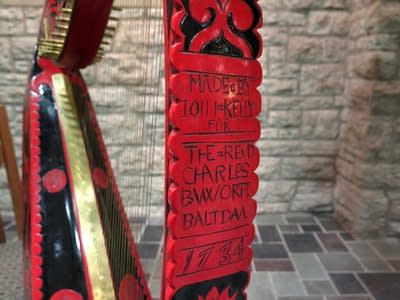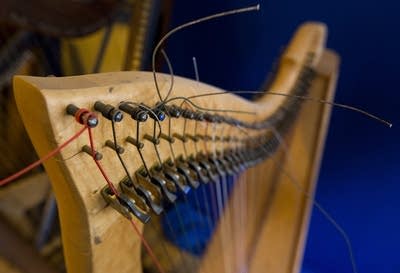From Duluth, harpmaker masters an Irish art

Go Deeper.
Create an account or log in to save stories.
Like this?
Thanks for liking this story! We have added it to a list of your favorite stories.
David Kortier doesn't claim Irish heritage.
But he makes authentic early Irish harps, the kind played by Ann Heymann, an Irish harp music scholar and performer who lives in Winthrop in southern Minnesota.
The two Minnesotans are at the forefront of preserving authentic Irish harp music. They met at a music conference 15 years ago when Heymann was looking for someone who makes the instruments.
Kortier has been making Irish harps in Duluth for more than 20 years, one of only a handful of people in the world to preserve the craft.
Turn Up Your Support
MPR News helps you turn down the noise and build shared understanding. Turn up your support for this public resource and keep trusted journalism accessible to all.
The harp market is limited, but Kortier, 70, has found a niche.
"If you got a symphony, you need a harp," he said. "And if you've got some people interested in Celtic music you might have a harp player."
Kortier's workshop in the city's Central Hillside neighborhood is a former neighborhood convenience store that once housed a real estate office.
The harp building begins out in back on a sawmill powered by a four cylinder, turbocharged diesel engine. Kortier discovered a local wood source years ago when investigating a noise up the street.
"There was this big truck up there with this monster, big log on it," he recalled.
Kortier struck a deal with the Rick Hanson Tree and Stump removal crew to drop the huge silver maple log in back of his shop.

Since then, the company also brings him white willow logs — the tough, elastic wood favored by Irish harpmakers hundreds of years ago.
Because early harpmakers couldn't rely on glue to hold their harps together in Ireland's damp climate, they carved the instrument's sound box from a solid block of willow.
That's how Kortier makes his Irish harps. But he does rely on modern wood working tools, including band saws and planers.
Combining fine woodworking and art, he creates harps of different sizes. Some can be held on the musician's lap, and others stand on the floor or rest on a pedestal. He carves Gaelic inscriptions or decorative patterns into many of them.
One of his best-known projects, a replica of the Bunworth early Irish harp, is painted in black and red, with elaborate carvings. It is topped with the head of Queen Mary of Modena.
Kortier has taken the 300-year-old early Irish harp design into the digital age. He makes electronic pickups and on request can place them in the harp sound box. The harp string rests against the pickup and when plucked creates an electronic pulse that can be amplified.
A native of Toledo, Ohio, Kortier played stringed instruments growing up. He switched to the bassoon in college while earning a master's degree in performance from Ohio State University. He accomplished his goal of playing in the Columbus Symphony Orchestra.
"I don't want to play the bass anymore, you have to stand in the back there. Bassoon you always get to sit down," he said with a laugh.
But the life of a musician was part-time work, so to make a living, Kortier began repairing instruments.
That evolved into making stringed instruments including harps.
His harp-making education started in the early 1980s when he moved to Duluth. He borrowed the instrument of Duluth harpist Georganne Hunter, copied it and sold it. He made more and sold them to Hunter's harp students.
At a music convention a few years later, he met Heymann, who had heard about a plan to build a replica of the famous Bunworth harp housed at the Museum of Fine Art in Boston. Kortier won the assignment of making a copy.

By then, Kortier had visited the National Museum of Ireland, among other institutions, where curators allowed him, under their watchful eyes, to make measurements and take pictures of early Irish harps. There are fewer than two dozen left, most made in the 1700s.
Since then, the self-taught craftsman has made a living at it.
"If you understand how the instrument is supposed to work and you understand the principles of wood working and if you're a thoughtful, careful person you can do this," he said.
Kortier said he's one of maybe two or perhaps three people in the world who make authentic Irish harps.
Customers span the globe.
A harp player in Germany has placed an order for a copy of an old and highly specialized instrument.
"It was a cross-strung, chromatic, wire-strung early Irish harp," he said. "So it's totally unique."
Kortier said that three-year project will probably take another year to complete. He builds less complicated Irish harps in about two months.
Prices range from about $3,000 to $10,000 depending on the model.
Kortier has made harps for well-known U. S. artists Kim Robertson, Siobhan Armstrong and Bruce Kurnow.
He also contracts with the Harp Society of Ireland to make instruments for students who want to learn to play. He said harp enthusiasts in Ireland are cultivating a couple of instrument builders there.
Kortier has no plans for retirement, but he has no apprentices. So when he stops making the instruments in his Duluth workshop, that appears to be the end of the line.
The Irish harp tradition nosedived a couple hundred years ago as changing musical tastes and even politics affected the instrument's popularity.
Still, Kortier is confident the hand-plucked harp will survive even in a digital age where the music can be produced electronically.
"No matter how good it is, it does not have the human quality to it," he said of digital music. "And I think that even people who make their whole world about synthesized music would agree with that point."





